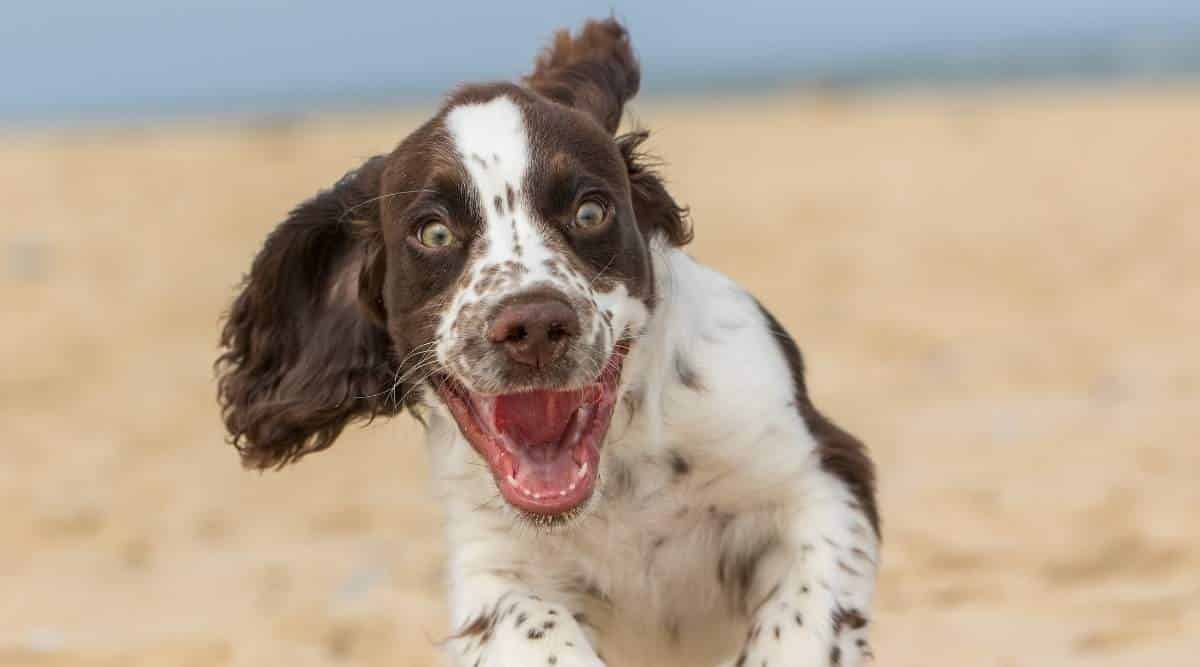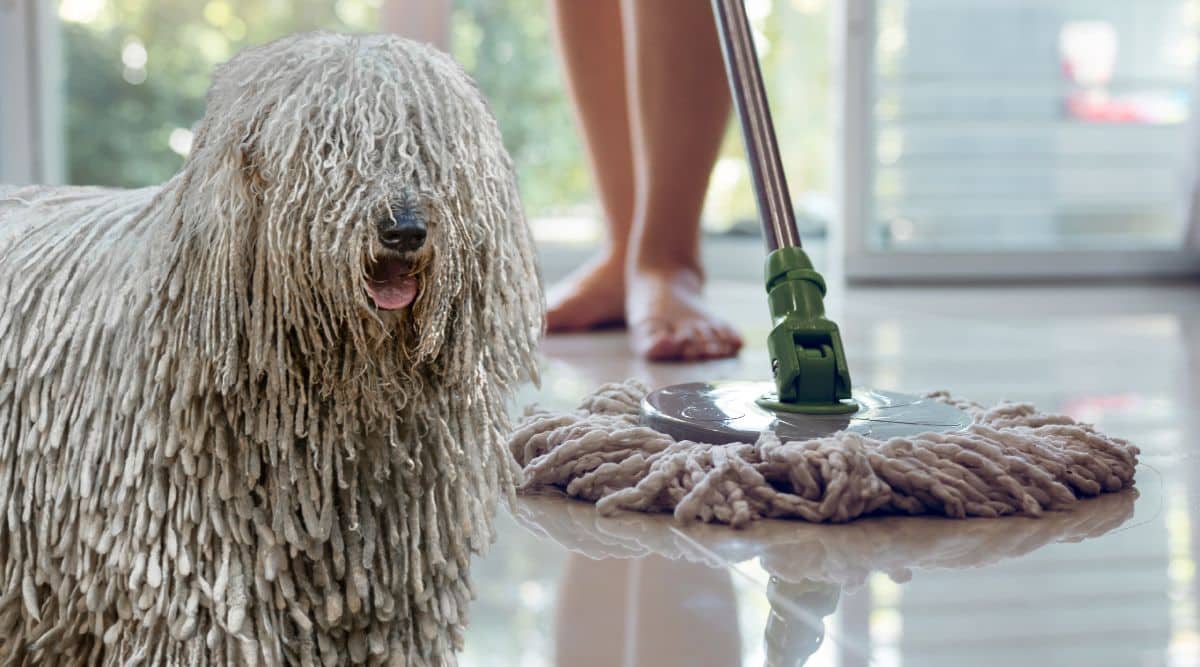American Pitbull Terrier Breed Information: Facts, Traits & More
When you purchase through links on our site, we may earn a commission. Here’s how it works.
The American Pitbull Terrier, APBT for short, is also commonly called the Pitbull or Pit. This should not be mistaken for the group of dog breeds referred to as Pitbulls. Not every dog called a Pitbull is an APBT, but they belong to this group, also called Bully breeds.
Table of Contents
There is a lot of discussion regarding Bully breeds, especially the American Pitbull Terrier. These dogs have a reputation for being aggressive and behind many dog bites and attacks. The breed does have aggressive roots, as they were first bred as fighting dogs. This breed and others referred to as Pitbulls, Pit Bulls, and Pitties get a lot of bad press because of this. Though the breed can be aggressive, it has more to it than genetics. Care and the living environment play a huge role. Most dogs of the breed are only aggressive if trained to be. However, many Pitbulls and mixes are strays or poorly cared for, which can lead to aggressive behavior.
This breed is, at heart, a big goofball who loves to play and is simply happy to be part of the family. Anyone considering the APBT or mixed pup for their next family pet should become well acquainted with the care needs, obstacles, and other elements of ownership. Let’s jump and learn more as we introduce you to the American Pitbull Terrier.
Defining Pitbulls
In general, the term Pitbull does not officially refer to one specific dog breed. This is a larger term often used to refer to dogs descended from Bulldogs and Terriers. There are four official Pitbull breeds. However, the American Pitbull Terrier is the breed most associated with the term.
Along with the APBT, the Red Nose American Pitbull Terrier, Blue Nose American Pitbull Terrier, American Staffordshire Terrier, Staffordshire Bull Terrier, and American Bully are the most referred to under the umbrella term of Pitbull.
History
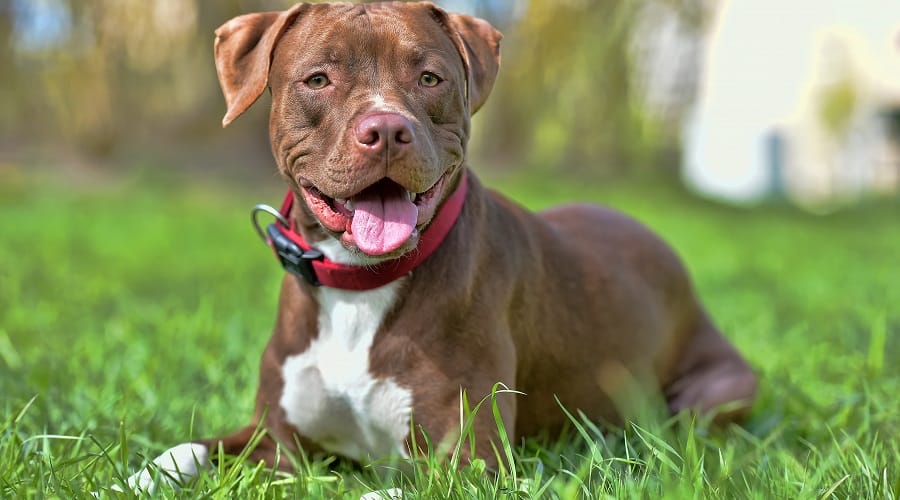
The American Pitbull Terrier, commonly known as Pitbull, originated in England in the 19th century. These dogs descend from Molosser-type breeds. They were bred from Bulldogs and Terriers for their strength and agility and used for bullbaiting, dog fighting, and ratting. These were immensely powerful, aggressive, fighting dogs.
Pitbulls were brought to America in the 1800s and became popular for hunting, herding, and as family guardians. Once here, they continued to be bred together to create powerful, large, fighting dogs. Eventually, the breed began being called the American Pitbull Terrier. They were bred and trained to be aggressive towards their opponents but docile to humans. This tendency to be gentle towards humans remains with the APBT. Bullbaiting and dog fighting has long been illegal, and the American Pitbull Terrier is now a popular pet.
Currently, the APBT is not recognized by the American Kennel Club (AKC), though the similar American Staffordshire Terrier is. The United Kennel Club and the American Dog Breeders Association recognize him. Some consider these canines to be the same, though the AKC does not recognize the APBT due to its long connection and association with dog fighting. The American Staffordshire Terrier is traditionally bred for competition standards. The American Pitbull Terrier is bred to be a companion animal. Though similar, these two breeds now have moderate differences in appearance and personality.
Unfortunately, due to their association with fighting dogs and illegal breeding, the American Pitbull Terrier often gets a bad reputation for being an aggressive, mean dog. However, these dogs are intelligent, gentle, and playful. Pitbulls and other Bully breeds have the nickname of nanny dogs due to their protective yet gentle nature and dogged devotion to their tiny playmates.
Temperament
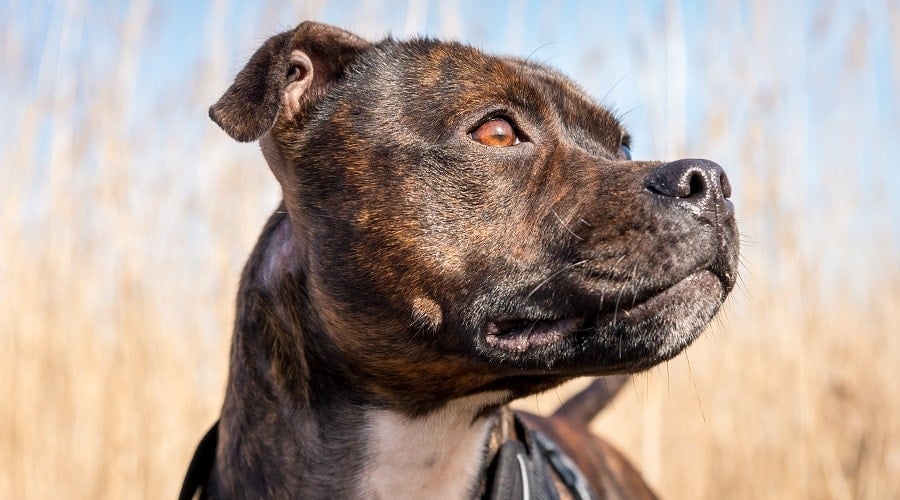
Though he has a reputation as a tough guy, the APBT is a big sweetheart. He is a colossal people-pleaser and always wants to be in the middle of things. He is a playful pup and has a gentle temperament. A very sociable pup, he is loyal and very attached to his family. He is confident, strong, and very enthusiastic.
The APBT does very well with human family members but may not like other dogs, especially other Pitbulls, very much. Of course, any dog can be trained to tolerate other pets. Owners must have patience and understanding while setting firm boundaries and behavior expectations.
Though this pup has a reputation as a guard dog, he is actually terrible at the job. He is incredibly friendly, and though he will bark when someone approaches, it is more likely because he is ready to greet them with a big smile than to detect danger. An APBT is incredibly social, meaning he must have socialization and proper behavior training from a young age. Of course, this stocky pooch is powerful and does have protective instincts. He will not hesitate to protect his people when actual danger is around.
The APBT is an intelligent dog who needs regular exercise and plenty of entertainment. It is essential to offer them a variety of toys, games, and different exercise routines to keep them interested. This guy might get clingy quite easily and dislike being left alone. He has a lot of energy, does well in families where someone is home, and has plenty of time to spend with him. Owners may want to consider crate training despite his larger size, as he can develop separation anxiety when left alone.
With proper training, lots of love, and care, the APBT is very obedient, curious, and very loyal. They can do well in smaller homes if given ample access to exercise and outdoor space. Though easy to train and agreeable, this pup might be a challenge for new owners simply because of the stereotypes and associations they carry.
Remember that much of the APBT’s temperament, demeanor, and aggressive behavior comes from training and the environment he is raised in. Dogs bred and raised to be fighters will be highly aggressive. Those raised to be pets are generally not prone to aggressive behaviors. It is always important to supervise children around any kind of Bully dog. Because some are bred for aggression or raised to be aggressive, it is important always to use caution and respect the space around them.
Size & Appearance
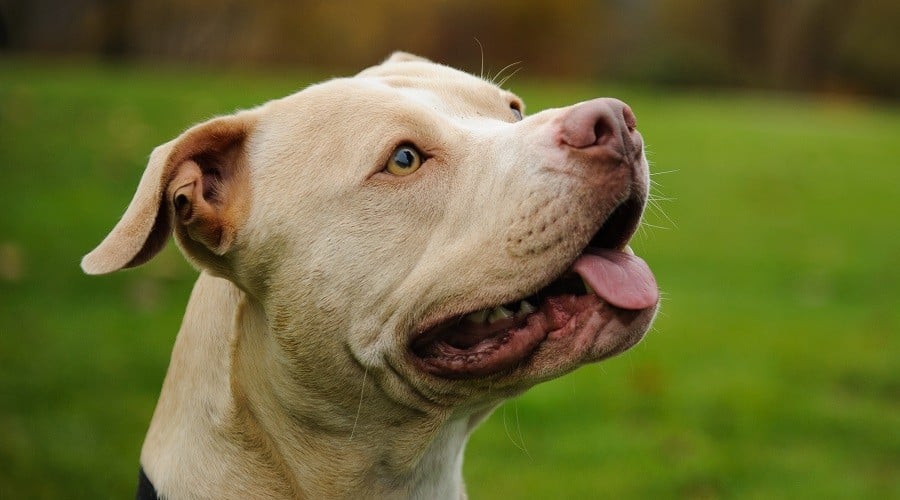
American Pitbull Terriers are short, compact, stocky dogs with a very muscular build and appearance. They weigh between 30 and 65 pounds as adults and stand 17 to 21 inches tall. Depending on their genetics, some may grow to be larger. They can reach up to 80 or so pounds. They are incredibly strong, with thick, agile muscles.
The APBT has a solid, broad head with thick, powerful jaws. They also have very thick necks and broad shoulders, which adds to their muscular, built appearance. They have tapered tails and thin coats. Pitties are born with drop ears that have folded flaps, called “rosebud ears.” When fully grown, they will flop over like those of a Labrador, with a slight upward curl.
Cropping a Pitbull’s ears is something that has been done for centuries. As these dogs were initially bred to be fighters, it is thought the practice started to help prevent their ears from being bitten or injured during a fight. The procedure is illegal and banned in many areas of the world, though still legal in some parts of the United States. Many people deeply oppose the practice. However, it is still performed by some breeders when puppies are very young, usually under 12 weeks old. Pitbulls with cropped ears have ears that stand upright rather than folding over.
Coat & Colors
The APBT has a short, glossy, shiny, single-layer coat. They are not soft but are not rough either. These dogs can come in many different colors, including white, gray, brown, black, brindle, red, blue, fawn, and tan.
He has a harder coat, which will not be as soft to the touch as some others. Though he does not require as much grooming as other canines, he needs regular brushing and periodic bathing. Regular brushing with a pin brush or stiff bristle brush and frequent wiping down with a damp cloth will help keep him clean. This is important to keep his coat shiny and prevent him from tracking dirt and debris inside.
Exercise & Living Conditions
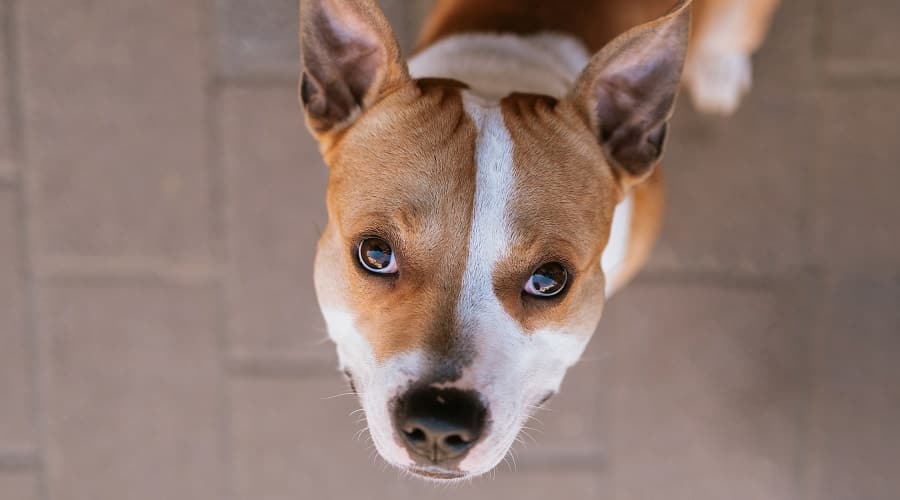
He needs regular daily exercise, at least an hour a day, to keep him healthy. This is not a good choice for owners who dislike going for walks, spending time outside, or exploring the great outdoors. He needs exercise and loves to go on adventures. A bored Pitbull will become destructive, can develop anxiety, and start to exhibit unruly behavior, so exercise is critical for this breed.
Try to start leash training him very young, as well as provide him opportunities to socialize with other dogs. This guy loves to make friends at the dog park. However, because of his scary reputation, he must be well-trained. Investing in the proper size leashes, collars, and harnesses is important. He is a very smart canine and very much enjoys his time outside, so ensure he has proper training for the dog park, neighborhood walking, and interaction with other dogs and people.
He will need a lot of toys because he is a busy boy and can be quite destructive. Ensure to provide him with a rotating mix of toys and regular access to outdoor space. Be careful not to overexert him, and try to spread exercise sessions out throughout the day. Though he needs at least an hour daily, he will gladly play more.
Pitbulls can live happily in an apartment setting, though this may be tricky. Because the breed is often banned, finding an apartment that will allow them may be tricky. Additionally, because they need so much training and exercise, they may need more space to meet their needs fully. They should be in homes, condominiums, or even apartments with access to a private outdoor space.
Additionally, this is not a good pup to leave home alone in an apartment, as they can develop separation anxiety and can become destructive. You do not want barking or other noises to become a problem or complaint for neighbors.
Training
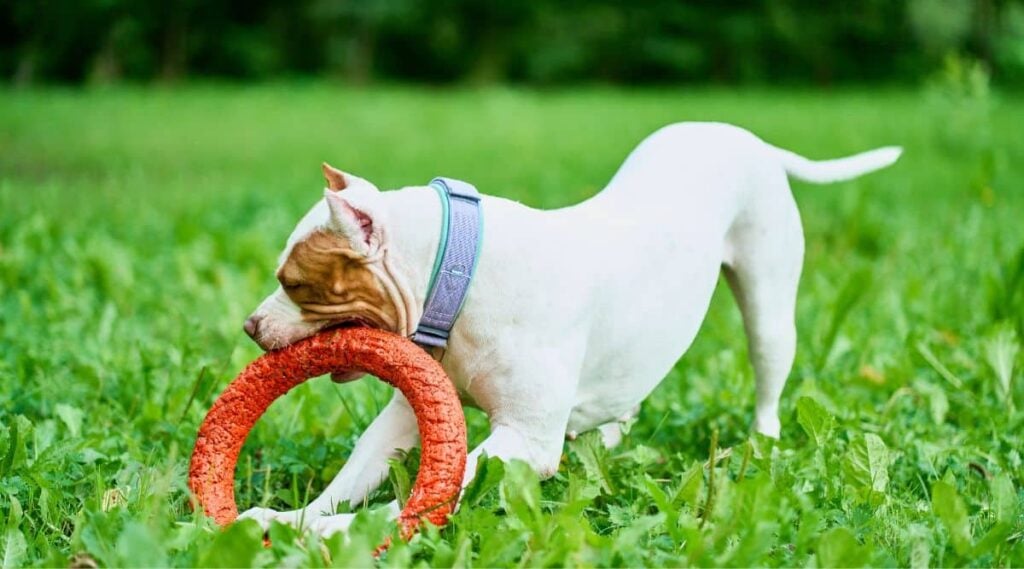
Owners should start training as soon as possible to instill a gentle demeanor and proper behavior expectations in their dogs from a young age. Early socialization is crucial, as this breed can develop fear and aggression. Ensure your pup interacts with other dogs as soon as he has had all his puppy vaccinations and is safe to be around other dogs.
This Bully breed loves nothing more than to do a good job and please his owner. He is much easier to train than one might think. He will pick up on tricks and commands reasonably quickly. Positive reinforcement techniques work better, so owners should consider clicker training, treats, special toys, and other rewards. This pup is very reward-driven, so once you find something your dog likes, he will likely be happy to perform for that reward.
Using incentives like positive rewards is a good approach for training the APBT, though they need to set firm boundaries. Owners who have trouble should enroll their pooch in puppy obedience classes, private, professional training, or a doggy boot camp sooner rather than later. Proper training and behavior are essential for the Pittie to be welcome at the dog park, the neighborhood park, and the boarding facilities.
It is essential to train and socialize the APBT properly. Owners must be responsible if bringing home one of these breeds. Over 4 million dog bites happen in the country every year, many of which are attributed to Pitbulls or Pitbull mixes. It is important to know that some bite circumstances result from provocation or fear, and other times may be related to aggression. Owners must take care to ensure their dog does not engage in bite behavior, especially with a breed known for being aggressive and having a history of biting.
Health
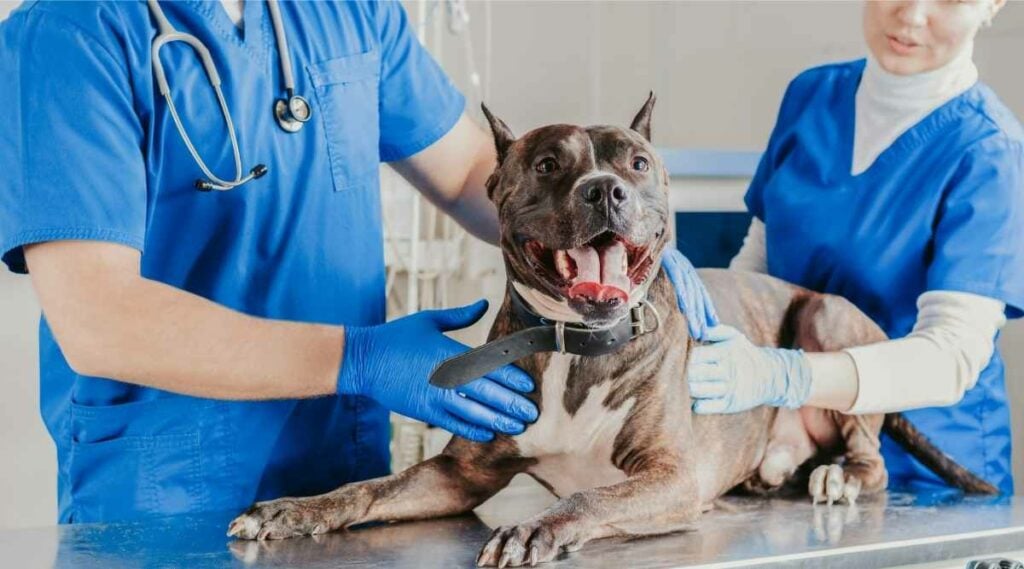
Overall the American Pitbull Terrier is a very healthy breed that lives between 12 and 16 years. The breed is prone to skin allergies, including a common allergy to grass. Cerebellar Abiotrophy is another condition that often develops with the Pittie. Some common health conditions to know about include:
Hip Dysplasia
Hip dysplasia is a common condition and can be quite painful. It occurs when a dog is still growing. It causes the hip joint to be loose, which impacts normal function. As a dog grows, cartilage and bone wear down, leading to muscle atrophy, arthritis, pain, and limited mobility. This condition is hereditary. It is one of the most common causes of hip arthritis in dogs.
Congenital Heart Disease
This breed has a high occurrence of congenital heart defects and disease. Congenital heart defects are present at birth and are caused by a variety of factors, including genetic defects, infection, or environmental conditions. Aortic stenosis is a disease that affects the valves of the heart. Heart disease often does not show symptoms, so it is vital to have your dog checked regularly and pay attention to things like new heart murmurs, respiratory issues, or other signs that your pet may be in distress.
Gastric Dilatation and Volvulus
This is a life-threatening condition also known as bloat. It often affects large and giant breeds and those with deep chests. This condition occurs when the stomach becomes blocked and fills with fluid and gas. This causes the stomach to stretch, which is quite painful. It can also cause a dog’s stomach to twist, cutting off the blood supply and causing a fatal reaction. Canines with bloat need immediate emergency medical treatment as this condition can become fatal within just a few hours.
Thyroid Dysfunction
Pitties can be at risk for thyroid dysfunction and disease. This is a fairly common problem among canines of many breeds. The thyroid produces hormones that help regulate metabolism growth and other hormones. Thyroid dysfunction can lead to exercise intolerance, lethargy, weight gain, and skin thickening, among other symptoms. This condition is treatable with medication but will need testing to identify and diagnose.
Cerebellar Abiotrophy
This is an inherited degenerative disorder In which the disease causes cells of the cerebellum to die. It affects mobility and cognitive function. This disease is chronic and degenerative. Canines will eventually lose their balance and coordination, and the disease will gradually become quite severe. This is also called cerebellar cortical degeneration.
Parvovirus
This breed is highly susceptible to parvovirus, particularly if unvaccinated. It is important to vaccinate young puppies at around six weeks old. It is best to continue parvo vaccination for this breed at least once a year as adults.
Owners may want to consider pet insurance to help offset the cost of emergency care. Make sure to look into this early, as many plans will not cover pre-existing conditions at enrollment.
Nutrition
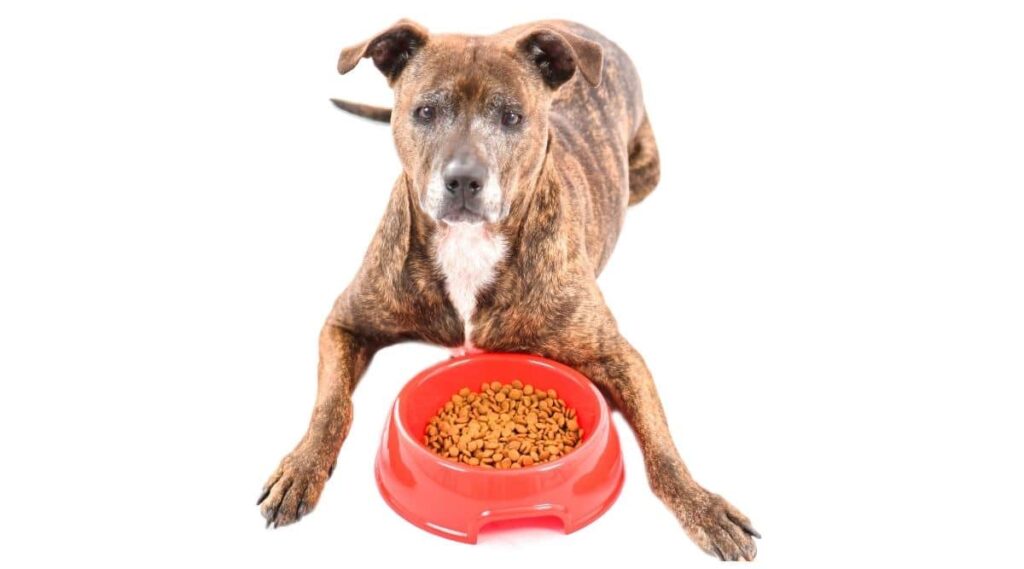
High-quality animal protein is best. Adults and puppies have different nutritional needs. Puppies will need higher calories and fat. The average adult weighs 45 pounds and consumes about 1100 calories per day. Those who work harder may need more calories. Senior pups will need fewer calories and may need foods with supplements like glucosamine and chondroitin to support joint health.
When looking for the best food for your Pitbull, reading food labels and looking for high-quality ingredients is essential. Stick to brands that use natural, whole animal proteins, and avoid unnamed meat byproducts or plant protein fillers. Always look for foods that meet the nutritional content guidelines of the American Association of Feed Control Officials (AAFCO).
High-quality nutrition is essential from the very first day your puppy comes home. Nutrition is the cornerstone of his health and will impact everything from growth and energy to life expectancy. Always try to pick the best food that you can afford. There are plenty of options to choose from, including kibble, wet food, fresh food made with human-grade ingredients, freeze-dried foods, and more. If you are concerned about your dog’s nutrition at any stage, consult your veterinarian before making any significant changes.
Look for foods that use high-quality meats, vegetables, and fruits, and stay away from those with artificial colorings, fake flavorings, or fillers like lots of corn and wheat gluten.
Grooming
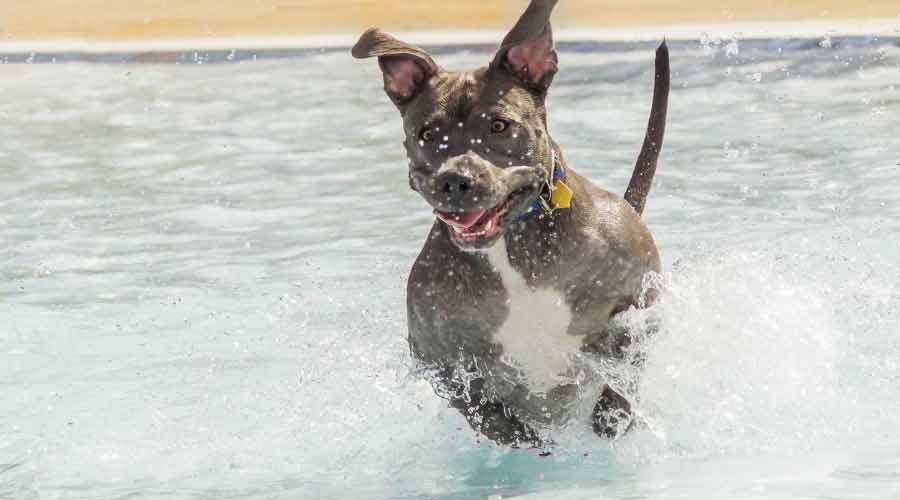
The good news for Pitbull owners is that this breed is relatively low maintenance when it comes to grooming. Some APBTs like to roll in the dirt and may require brushing more often. Once or twice a week is best. Be careful not to over-brush, as this breed has a thin coat and sensitive skin. They may require a bath once every six weeks to two months. Again, this may need to happen more often, depending on how dirty your pup gets.
Make sure to invest in high-quality brushes and grooming tools, as well as a tear-free dog shampoo. It is also essential to pay attention to nail clipping and dental care. Dental disease can develop in canines as young as two years old and take multiple years off their life expectancy if not caught early. The best treatment is prevention. Train your puppy young to tolerate brushing at least twice weekly and regular nail clipping. If you are uncomfortable with teeth cleaning and nail clipping, ask your veterinarian or invest in the help of a trainer, as these are critical areas of your pet’s health.
Common Misconceptions About Pitbulls
One of the most common misconceptions about Pitbulls is that they are inherently aggressive and dangerous. This is simply not true. Like all pets, Pitbulls are a product of their environment and their upbringing. With proper training and socialization, most Pitbulls can be as friendly and loving as any other breed.
There is a widespread belief that Pitbulls have something called a locking jaw. This is not something that any pure or mixed-breed dog has. Pitbulls have a very strong bite grip, as does any canine, so owners should work on training them not to bite and learn what to do should a bite happen.
Pitbulls are often perceived as aggressive dogs, but sadly, they are among the most mistreated dog breeds. This is because some owners may abuse them on purpose in order to provoke aggressive behavior. This abusive treatment leads to the widespread belief that all dogs of the breed are aggressive.
Breed Specific Legislation
Pitbulls are often susceptible to breed-specific legislation (BSL). This refers to laws prohibiting and regulating certain dog breeds’ ownership. The intent behind these dogs is to limit the public’s exposure to dangerous dog breeds. Most breed-specific legislation does target Pitbull and Pitbull mixes. This legislation can extend to any of the Bully breeds, including the APBT, American Staffordshire Terrier, American Bully, Staffordshire Bull Terrier, American Bulldog, and more. This legislation also often impacts hybrids and wolf dogs.
If you own a Pitbull or Bully mix or are planning to bring one home, it is essential to research breed-specific legislation in your area. This is most often on a municipal or county level, and some HOAs and multifamily living complexes may also prohibit them. BSL includes ownership and reproduction.
Breeders & Puppy Costs
There is a rather large price range for the APBT. Puppies range anywhere from $500 to $1,500 or more. A high-quality, high-pedigree puppy may even cost as much as $2,500. It is imperative that owners work with reputable breeders and avoid purchasing dogs from pet stores or puppy mills. Look for breeders who have performed health screenings and are willing to answer questions, and allow you to see parent dogs and previous litters. You can check with the American Dog Breeders Association and speak with your veterinarian to find reputable, high-quality breeders.
There are many breeders throughout the United States, so owners do not need to rush to find a puppy. Take your time, ask questions, read reviews, and ensure you work with a responsible breeder who raises healthy dogs. Keep in mind that along with the initial price of adopting a puppy, owners will need to spend $100 to $500 to get their dog set up with crates, beds, food, treats, toys, harnesses, leashes, and initial medical care. It is also essential to factor in the cost of any permits, registration, or microchipping required in your area.
Rescues & Shelters
The APBT is commonly present in animal shelters throughout the country. There are also several breed-specific rescue groups owners can look to adopt a dog. Shelters are full of animals needing loving homes, which cost much less to adopt than purebred puppies. Because of the prevalence of this breed, and their reputation for being aggressive, many shelters will euthanize them very quickly as they have a low chance of being adopted. Over one million Pitbulls are estimated to be euthanized in shelters annually.
This breed is estimated to spend two to three times longer in shelters than any other breed. Shelters are full of Pitbulls, and Pitbull mixes. This is due to their aggressive reputation, the banning of Pitbulls in some areas and by landlords, and because some breeds resembling Pitties are mislabeled.
There are many Pitbull advocacy and rescue organizations throughout the United States. These organizations work to educate the public about Pitbulls and to rescue and rehome Pitbulls that have been abandoned, neglected, or mistreated. Because Pitbulls are prevalent in shelters, finding both puppies and adults is possible. Some notable organizations include the American Pitbull Foundation and Pitbull Rescue Central.
As Family Pets
The APBT can make a fantastic family pet with proper care and treatment. They need a significant amount of attention and supervision. These dogs have a reputation for being aggressive, which may impact how others react to them. Owners must be aware of this and take appropriate steps to train them properly. This breed has a loyal, lovable personality and loves to be with his human family as much as possible. He is a people pleaser, highly trainable, and very smart. This guy needs a lot of room and plenty of exercise.
Taking on the ownership of a breed with a dangerous reputation is a big responsibility. Owners need to learn about breed-specific legislation and specific care needs. Take time to learn the misconceptions and truths about the APBT and how to ensure your dog has a happy, healthy life.
Final Thoughts
The American Pitbull Terrier is a magnificent breed with a checkered past. They come from a long line of fighting dogs but have long been popular as pets and working dogs. The APBT is an agreeable, sociable, friendly breed. Though he has a reputation for being aggressive, he is a big softy and makes a terrible guard dog. This breed makes a fantastic pet but requires an owner who can set firm boundaries and someone available to give him a lot of attention. Owners should be aware of breed-specific legislation and regulations or prohibitions on Pitbull or Pitbull mix ownership in their area.
Because this breed has a reputation for being dangerous and has been involved in several dog bites, owners must ensure they have a safe, secure place for their dogs and constantly supervise them with strangers and children. As with any breed, these dogs need lots of love, regular medical care, and consistent training. With the right owner, this breed is nothing but a big sweetheart and will happily accompany his owner anywhere from the couch, to the dog park, to the top of a mountain.


